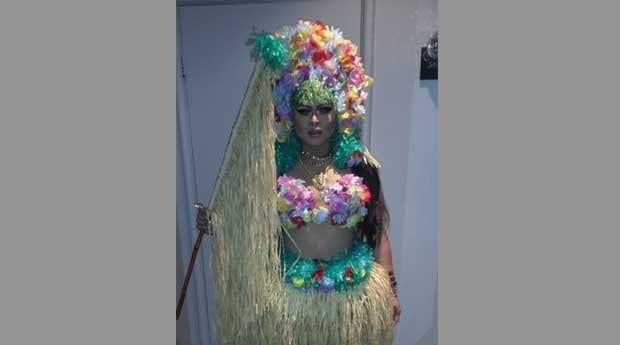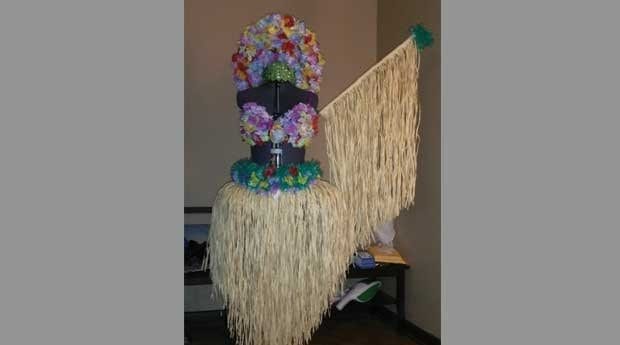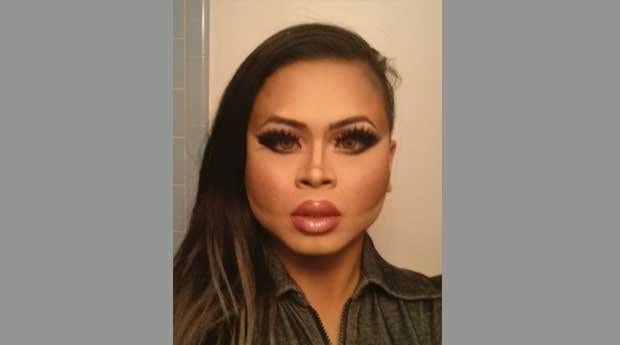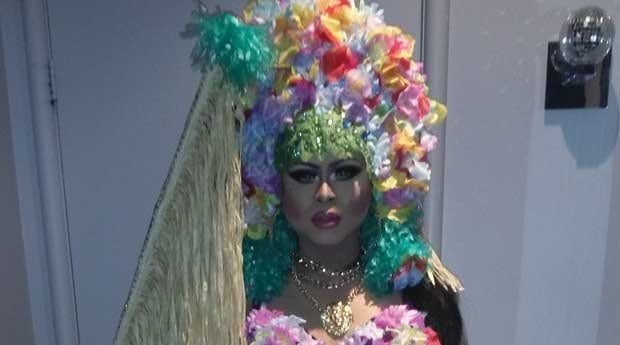
London says she understands that some people were offended but feels the situation was handled poorly by the Pride Centre. Credit: Jade London

The outfit London wore was inspired by dashboard hula dolls. She performed to the song “Right There” by Nicole Scherzinger. Credit: Jade London

Drag performer Jade London. Credit: Jade London
A recent drag performance at the Student Federation of the University of Ottawa (SFUO) Pride Centre took an uncomfortable turn, performer Jade London says. London took to the stage on May 4 wearing a Hawaiian-themed outfit and says she was asked by the Pride Centre not to return when her number was over.
The outfit London wore consisted of a grass skirt paired with a floral headdress and bra. She was inspired, she says, by dashboard hula girls, identifying with their kitschy, doll-like appearance. She performed to the song “Right There” by singer Nicole Scherzinger, who is of Hawaiian, Filipino and Russian descent.
“The reason why I chose ‘Right There’ as a song is because there’s a little bit of a tribal beat to it, and [the outfit] kind of fit with it,” London says. “At that moment I really felt that that song best fit it.”
London says the Pride Centre’s service coordinator took her aside after her performance and expressed that several audience members had been offended by what they felt was the racialized nature of her outfit and had chosen to leave the show.
“My feelings were so hurt, mainly because in my mind at the time, I honestly didn’t feel I did anything wrong,” London says. “Me as an entertainer, I’m not there to offend. I’m not there to hurt somebody’s feelings, I’m not there to judge anybody in the audience.”
London says the coordinator expressed to her that audience members had felt the outfit to be a form of cultural appropriation and then informed her that she would not be allowed to return to the stage for her final performance. She says she was also asked not to enter the university’s Pub 1848. When she offered to apologize, London says she was told the Pride Centre would do so on her behalf. The SFUO Pride Centre declined to speak with Xtra for this article.
Whether taking inspiration from another culture in the name of art is a form of appropriation is a difficult and much-debated question. “I think the question of cultural appropriation specifically of indigenous peoples and cultures is very important for drag performers and for all of us to think about,” says Kathryn Trevenen, a professor of women’s studies at Ottawa U whose research focuses on LGBT rights and postcolonial theory.
“I don’t think that a drag performance justifies appropriation of a person’s culture, specifically in the case of indigenous cultures because of the history of the appropriation of [those] cultures.” She points out that universities are notorious for their exploitation of indigenous knowledge and that Ottawa U itself is built on unceded Algonquin land.
In drag, it isn’t uncommon for a performer of one ethnicity to take to the stage in the guise of another, for instance an Asian queen performing as Nicki Minaj or Lady Gaga. But there is a difference, Trevenen says, between adopting the persona of an individual and that of an entire culture.
“I think it’s very powerful that Jade didn’t understand the politics of the outfit that she was using,” she says. “I also think that the only way we can ever learn is by entering into dialogue with people. I’m really sympathetic to the idea that someone can do something like that without intending to harm anyone, for sure. But I still don’t think that’s a justification for continuing to do it.”
“I think one of the things that non-indigenous people have to really question is their privilege when they assume that they should be able to take up indigenous dress or symbols or ideas, because this is the sort of backbone of colonial exploitation in a lot of ways.”
London says that for her, part of the reason she sometimes portrays other cultures is that she doesn’t want to be restricted in her material. “For me, I’m Asian, right, so what possible artists are there that are well known that are Asian? It’s really hard for me to pick a song that was within my own ethnicity, and I don’t feel that it is essential,” she says.
She also says that she would have been open to constructive criticism from the Pride Centre and that she would have been happy to change outfits if she had been asked to. “If I thought it was offensive, I wouldn’t have done it. And if I didn’t know it was going to offend somebody, that just means I didn’t know.”
But regardless of intent, Trevenen says it is still important for drag performers to consider the implications of how they portray themselves. “I personally feel in instances like this that [we] should be guided by the group of people that those images belong to . . . I think that many indigenous folks are very articulate about why other non-indigenous people using their symbols or dress or beliefs is problematic.”
Although she says she’s still hurt by the Pride Centre’s actions and feels they should have backed her up as a performer, London doesn’t assign blame for how the situation was handled solely to the service coordinator.
“I love the people that are part of the organization; I like them and I’ve never had problems with them before,” she says. “I don’t know where [the coordinator’s] words came from. I don’t know if they were influenced by the crowd or other people within that organization or if it’s their own personal feelings.”
She also feels the Pride Centre’s decision to apologize on her behalf was wrong. “I understand that people were offended. I understand that they were hurt. I just — I want to make it better because I’m not like that,” she says. “I didn’t want people to feel that I left . . . I don’t feel that the apology would have been sincere if I was running away and hiding from them.”
“I understand that people aren’t going to like certain things that I do, but you can’t judge me as a person. And I was judged as a person, as an individual, and I was hurt that way.”
For more on drag and cultural appropriation, see
dailyxtra.com/toronto/news/drags-dilemma
dailyxtra.com/toronto/news/daytona-bitch-fired-official-td-pride-drag-queen-blackface


 Why you can trust Xtra
Why you can trust Xtra


